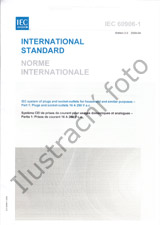Potřebujeme váš souhlas k využití jednotlivých dat, aby se vám mimo jiné mohly ukazovat informace týkající se vašich zájmů. Souhlas udělíte kliknutím na tlačítko „OK“.

IEC 62364-ed.2.0
Hydraulic machines - Guidelines for dealing with hydro-abrasive erosion in Kaplan, Francis and Pelton turbines
Přeložit název
NORMA vydána dne 14.1.2019
Informace o normě:
Označení normy: IEC 62364-ed.2.0
Datum vydání normy: 14.1.2019
Kód zboží: NS-935971
Počet stran: 150
Přibližná hmotnost: 481 g (1.06 liber)
Země: Mezinárodní technická norma
Kategorie: Technické normy IEC
Kategorie - podobné normy:
Anotace textu normy IEC 62364-ed.2.0 :
IEC 62364:2019 gives guidelines for: a) presenting data on hydro-abrasive erosion rates on several combinations of water quality, operating conditions, component materials, and component properties collected from a variety of hydro sites; b) developing guidelines for the methods of minimizing hydro-abrasive erosion by modifications to hydraulic design for clean water. These guidelines do not include details such as hydraulic profile shapes which are determined by the hydraulic design experts for a given site; c) developing guidelines based on “experience data” concerning the relative resistance of materials faced with hydro-abrasive erosion problems; d) developing guidelines concerning the maintainability of materials with high resistance to hydro-abrasive erosion and hardcoatings; e) developing guidelines on a recommended approach, which owners could and should take to ensure that specifications communicate the need for particular attention to this aspect of hydraulic design at their sites without establishing criteria which cannot be satisfied because the means are beyond the control of the manufacturers; f) developing guidelines concerning operation mode of the hydro turbines in water with particle materials to increase the operation life. It is assumed in this document that the water is not chemically aggressive. Since chemical aggressiveness is dependent upon so many possible chemical compositions, and the materials of the machine, it is beyond the scope of this document to address these issues. It is assumed in this document that cavitation is not present in the turbine. Cavitation and hydro-abrasive erosion can reinforce each other so that the resulting erosion is larger than the sum of cavitation erosion plus hydro-abrasive erosion. The quantitative relationship of the resulting hydro-abrasive erosion is not known and it is beyond the scope of this document to assess it, except to suggest that special efforts be made in the turbine design phase to minimize cavitation. Large solids (e.g. stones, wood, ice, metal objects, etc.) traveling with the water can impact turbine components and produce damage. This damage can in turn increase the flow turbulence thereby accelerating wear by both cavitation and hydro-abrasive erosion. Hydro-abrasive erosion resistant coatings can also be damaged locally by impact of large solids. It is beyond the scope of this document to address these issues. This document focuses mainly on hydroelectric powerplant equipment. Certain portions can also be applicable to other hydraulic machines. This second edition cancels and replaces the first edition published in 2013. This edition constitutes a technical revision. This edition includes the following significant technical changes with respect to the previous edition: a) the formula for TBO in Pelton reference model has been modified; b) the formula for calculating sampling interval has been modified; c) the chapter in hydro-abrasive erosion resistant coatings has been substantially modified; d) the annex with test data for hydro-abrasive erosion resistant materials has been removed; e) a simplified hydro-abrasive erosion evaluation has been added. Key words: Hydraulic Machines, Hydro-Abrasive Erosion, Kaplan, Francis, Pelton Turbines. LIEC 62364:2019 donne des lignes directrices pour: a) presenter les donnees disponibles concernant les taux derosion hydro-abrasive avec diverses combinaisons de qualite de leau, conditions dexploitation, materiaux et proprietes des composants; ces donnees ayant ete obtenues sur differents sites hydroelectriques; b) developper des lignes directrices permettant de reduire au minimum l’erosion hydro-abrasive en apportant des modifications a la conception hydraulique normalement utilisee en l’absence de particules. Ces lignes directrices n’abordent pas les details tels que les profils hydrauliques que les specialistes en conception hydraulique determinent pour un site donne; c) developper des lignes directrices etablies sur le «retour d’experience» concernant la resistance relative de materiaux confrontes aux problemes d’erosion hydro-abrasive; d) developper des lignes directrices concernant la maintenabilite des materiaux resistant a lerosion hydro-abrasive et des revetements de surface durs; e) developper des lignes directrices relatives a la recommandation dune methode, que les proprietaires pourraient appliquer, et dont il convient quils lappliquent effectivement, afin de sassurer que les specifications montrent la necessite daccorder une attention toute particuliere a la conception des formes hydrauliques propres a leur site sans imposer des criteres qui ne peuvent etre satisfaits dans la mesure ou les moyens a mettre en ouvre ne sont pas maitrisables par les constructeurs; f) developper des lignes directrices concernant le mode de fonctionnement des turbines hydroelectriques en presence de particules afin d’accroitre la duree de vie. Ce document fait lhypothese d’une eau chimiquement non agressive; etant donne que cette agressivite depend des diverses compositions chimiques possibles, ainsi que des materiaux constitutifs de la machine, le domaine dapplication de ce document ne traite pas de cette question. Ce document fait egalement lhypothese de labsence de cavitation au niveau de la turbine. En effet la cavitation et lerosion hydro-abrasive peuvent se renforcer mutuellement de sorte que lerosion resultante est plus importante que la somme des deux. Comme aucune formulation quantitative de cette erosion resultante n’est connue, ce document na pas pour objet de levaluer, sauf pour suggerer, lors de la phase de conception de la turbine, des efforts particuliers visant a minimiser la cavitation. Des objets solides de grandes dimensions (comme des pierres, du bois, de la glace, des objets metalliques, etc.) vehicules par leau peuvent percuter les composants de la turbine et les endommager. Ces dommages peuvent pour leur part accroitre la turbulence de l’eco
Odebírejte informace o nově vydaných normách ZDARMA:
Chcete pravidelně odebírat informace o nově vycházejících normách z celého světa a to zcela zdarma?
Přihlašte se k odběru. Vše je velice jednoduché a absolutně ZDARMA.
Na výběr máte vydavatele z celého světa.



 Cookies
Cookies
